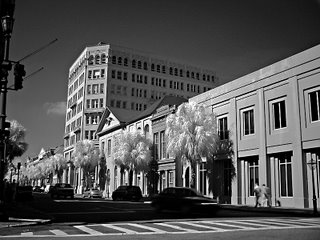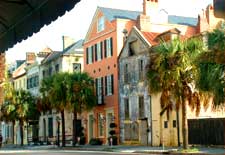Take a trip to the Carolinas and you can't help but notice a few quality of life items worthy of note on this blog.
First off, no sooner does one leave Long Island do the roadways -- including the Interstates -- appear cleaner. Are we simply slobs here on the Island, or are municipalities more in tune with both task and tax dollar west of the Nassau County line?
Next, venture south of the Mason-Dixon line, and you'll find that the South did, contrary to popular belief, win the war. At least in terms of rebuilding and re-energizing communities -- whose relative age eclipses that of America's first suburb by some 200 years -- the reconstruction of southern towns and cities makes Nassau's plans to redesign the hub look like a kid with his first set of Lincoln Logs.
 Take Charleston, South Carolina, for example. A historic town -- a city, actually, though it retains that "small-town" ambiance thanks to its architecture and walkability -- pre-dating the American revolution, with more than its share of blight and brownfields.
Take Charleston, South Carolina, for example. A historic town -- a city, actually, though it retains that "small-town" ambiance thanks to its architecture and walkability -- pre-dating the American revolution, with more than its share of blight and brownfields.There are, perhaps, few places in America more charming and picturesque than Charleston, and few "downtowns" that have risen to the occasion in reinvigorating both town center and suburb.
In fact, Charleston has, in recent years, become known as Charrette Central, residents and city officials giving serious mind to multiple visioning processes, severl of which have taken the leap from drawing board to Main Street.
A virtual laundry list of projects are now under consideration, with a host already completed and fluorishing.
 Downtown Charleston itself is undergoing a renaissance of sorts (and I tell you, it look's nothing like Nassau's hub, where residents will be breathing down one another's necks in overpriced 2' x 4' units crammed side-by-side on a former raceway, overlooking the County's tallest structure -- the Ref-Fuel resource recovery plant). Over 1600 residents -- from the youngest school children to the city's senior set -- are taking part in Charrettes, and actually seeing their vision of "downtown" take shape.
Downtown Charleston itself is undergoing a renaissance of sorts (and I tell you, it look's nothing like Nassau's hub, where residents will be breathing down one another's necks in overpriced 2' x 4' units crammed side-by-side on a former raceway, overlooking the County's tallest structure -- the Ref-Fuel resource recovery plant). Over 1600 residents -- from the youngest school children to the city's senior set -- are taking part in Charrettes, and actually seeing their vision of "downtown" take shape.Revitilization and Development
Completed in 2000, The South Carolina Aquarium, showcases exhibits of South Carolina's waterways from the mountains to the sea and includes thousands of animals and plants. Also completed in 2000, and located adjacent to the South Carolina Aquarium, is the new IMAX Theatre.
The Ashley River Walkway - a combination bikeway and promenade - is in the planning stages and will wrap around the eastern side of the Peninsula. Ultimately, the Walkway would link the new City baseball stadium, just north of Brittlebank Park on the Ashley River, with the South Carolina Aquarium
A major catalyst in the City's revitalization was the completion of Charleston Place in 1986. This luxury hotel/retail complex draws a steady stream of customers to its shops as well as to neighboring stores and restaurants along King, Meeting and Market Streets. With the Hampton Inn redevelopment, the refurbishment of the stately Francis Marion Hotel and the conversion of the old Citadel into Embassy Suites, this area is experiencing a resounding boom. A well-appointed landmark, Marion Square Park is undergoing a redesign and will be entirely surrounded by development successes and two revered churches.
In 1991, Charleston opened the gates to its Visitor Reception and Transportation Center (VRTC) on Meeting Street. The VRTC represents a significant alliance of historic preservation and tourism management. It is housed in an 1856 railroad freight station. In the renovation of the structure, the City has salvaged the rustic feel of the old depot - original beams and pine floors still greet the Charleston visitor.
Several other developments enlivened the City and secured its position as a wonderful place to live. In 1990, the City completed the Waterfront Park - an eight-acre linear park and pier along the Charleston Harbor entry. The park masterfully combines spectacular fountains, spacious lawns, intimate garden "rooms", plenty of walking and jogging paths and a long wharf with picnic tables and wooden swings. Additional waters-edge projects afford greater public access to the water, including the Charleston Maritime Center, which will establish a permanent home for the shrimping industry and include a special events pier with public access to the water.
Another extraordinary economic opportunity avails itself as a nearby sixty-five acres, known as Union Pier, offers prime development sites for hotel, retail, office and residential, deep in the historic district. A full complement of boulevards, parks and vistas are planned to ensure an ambiance befitting the historic district.
Housing
Charleston's signature housing type is the "'single house" - a narrow house with gracious side piazzas. The single house is but one choice in an ample range of housing indigenous to Charleston. From marshfront condominiums to downtown studio and from four-bedroom homes to splendid mansions in the historic district, every domestic setting can be realized. Charleston's single family market is strong; since 1987, single family production has averaged 310 new homes annually, and multi-family construction averages at 30.4 units per year.
 For years, Charleston has made national headlines for its innovative approaches to providing affordable housing. In addition to the award winning designs, the achievements include the incredible rebirth of the central city and a strong revitalization movement northward up the Peninsula and into the neck area. Through its Community Development Division, the City has provided over 2,000 housing units since 1990. The Charleston Housing Authority manages 10 public housing areas as well as 113 units which are scattered throughout the City. The task of providing affordable housing does not fall to City agencies alone. A variety of groups like Habitat for Humanity, Charleston Affordable Housing, Humanities Foundation, Charleston Crisis Ministries, many churches and dedicated individuals offer assistance in the quest to provide decent, attractive, affordable housing and to prevent homelessness. This production task force is leading the way by generating creative financing and design solutions.
For years, Charleston has made national headlines for its innovative approaches to providing affordable housing. In addition to the award winning designs, the achievements include the incredible rebirth of the central city and a strong revitalization movement northward up the Peninsula and into the neck area. Through its Community Development Division, the City has provided over 2,000 housing units since 1990. The Charleston Housing Authority manages 10 public housing areas as well as 113 units which are scattered throughout the City. The task of providing affordable housing does not fall to City agencies alone. A variety of groups like Habitat for Humanity, Charleston Affordable Housing, Humanities Foundation, Charleston Crisis Ministries, many churches and dedicated individuals offer assistance in the quest to provide decent, attractive, affordable housing and to prevent homelessness. This production task force is leading the way by generating creative financing and design solutions.Culture and the Arts
Throughout its history, Charleston has stood as a cultural capital of the South. The performing arts are well represented here with a symphony orchestra, community theater groups and several local ballet companies performing regularly. The Gibbes Museum of Art and numerous art galleries, along with the abundant examples of architectural excellence and craftsmanship, expose residents and tourists to the visual arts. The Charleston Museum, the oldest museum in North America, offers a captivating collection of artifacts depicting lowcountry life from the time of the first settlers through the twentieth century.
One thing that struck me about Charelston is the comprehensive nature of the city's revitalization plan. There actually is a Master Plan which incorporates what would otherwise appear to be the piecemeal rehabilitation of aging neighborhoods. More than mere pavers and street lamps, Charleston has thrown itself -- no, immersed itself -- in the rebirth of a nation's founding community as a 21st century leader in smart growth.
- - -
Yes, the south shall rise again. Indeed, it is, in Charleston, South Carolina. The question we have at The Community Alliance is, will Nassau County rise again -- or will we simply continue to sprawl from blight to brownfield, from spot attempts at revitalization to visions of light rail lines and towering lighthouses, from villages and hamlets caught hopelessly between nowhere and no place to that suburban utopia we can happily (and affordably) call "home?"
Write to us with your vision of the New Suburbia. info@thecommunityalliance.org
No comments:
Post a Comment